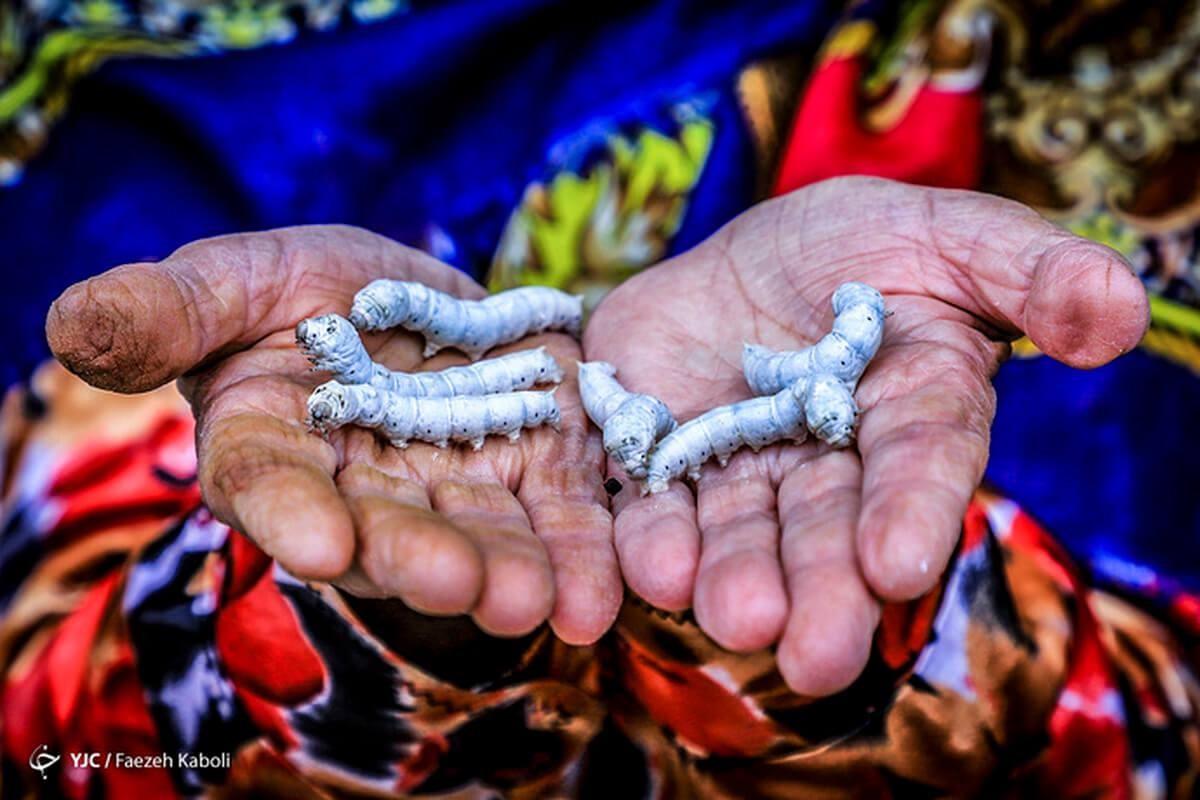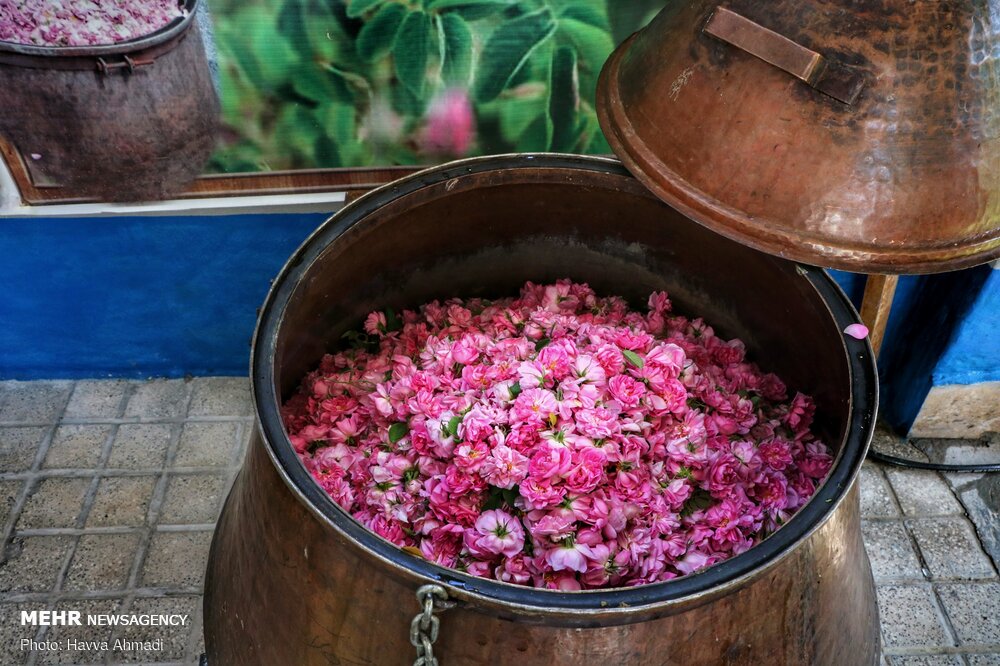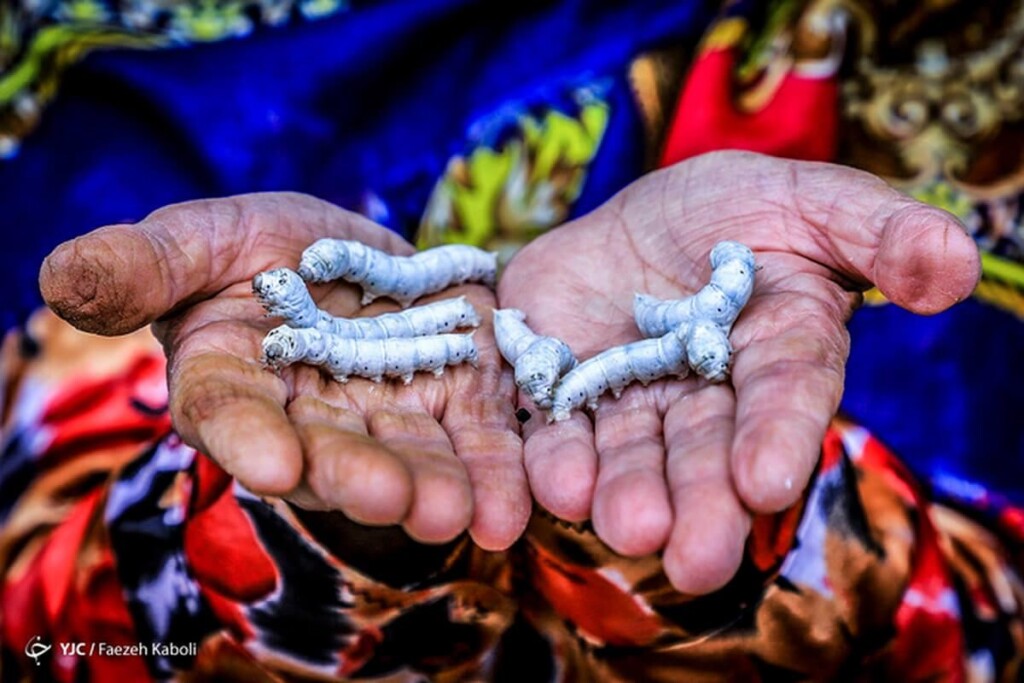
Near the end of 2022 and during the 17th meeting of the International Intangible Cultural Heritage Committee, sericulture and traditional production of silk for weaving in Iran and other countries were recognized as UNESCO World Heritage items.
Silk farming or Noghandari (Sericulture) are considered one of the side activities of agriculture because it is related to the planting and cultivation of mulberry trees. Nowadays, farmers consider this practice a convenient source of income since sericulture yields results in a short time and can be set up with a small investment.
This is the 21st item of Iranian intangible cultural heritage that is recognized by UNESCO. It was jointly registered with the countries of Afghanistan, Azerbaijan, Turkey, Tajikistan, Turkmenistan, and Uzbekistan. In this article, we will present the main elements of this practice.
History of Sericulture and Traditional Production of Silk for Weaving
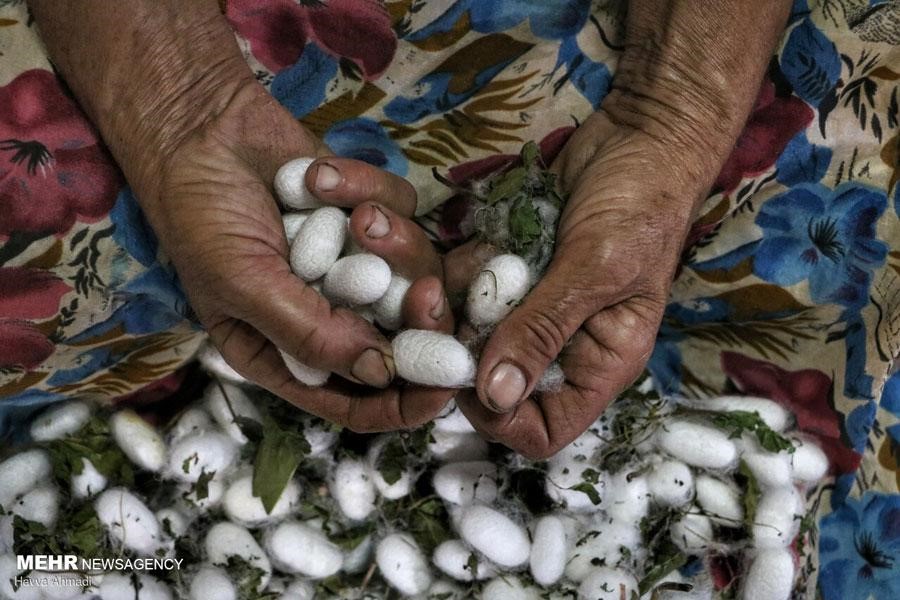
Wild silkworms have lived on mulberry trees since ancient times in different regions of the world, especially in West and East Asia. This type of worm, which feeds on the leaves of the mulberry tree, was first recorded about 4600 years ago in the forests of China.
This is why the Chinese were the first to practice sericulture and the traditional production of silk for weaving. After that, this craft slowly spread to other countries and reached Iran 1500 years ago.
The prime of silk production in Iran can be traced back to the Safavid era. During this period, the production of raw silk was estimated to be three thousand tons per year. Then, during the Qajar period, given the outbreaks of viral diseases and other issues, silk production decreased drastically and did not improve until 1979.
Then, one year after the 1979 revolution, the government invested in this industry by founding the Iran Sericulture Joint Stock Company. It is worth mentioning that the participation of Iranian villagers in the sericulture industry led to improvements in living standards and socio-economic conditions. They utilized the sericulture industry and traditional silk farms to weave carpets and other silk products.
Over time, with the development of the sericulture industry and the realization of its potential, it was necessary to make systematic and calculated plans. As a result, since 2004, the government assigned the Sericulture Research and Development Unit of the Iran Sericulture Company to the Agricultural Research Education and Extension Organization. Then this organization changed its name to the Iran Silk Research Center.
Which Cities in Iran Have Sericulture?
According to the surveys, the amount of silkworm egg production is much higher in four provinces including Gilan, Mazandaran, Khorasan, and Isfahan. In fact, the silkworm cocoon produced in these provinces can impact the economic status of thousands of silk production workers spinning and dying silks.
Currently, Gilan province is one of the most significant silk producers in the country with the production of 80% of wet silk cocoons that contain live worms. In the past, the annual production of silkworm eggs in the country was about 185,000 boxes, of which 150,000 boxes were produced in the Gilan province.
This amount has now decreased to 30,000 boxes, but Gilan province still produces a considerable portion. The apparent reason for this decline in silkworm egg production is the high production cost.
Cultivation of Mulberry Trees for Sericulture
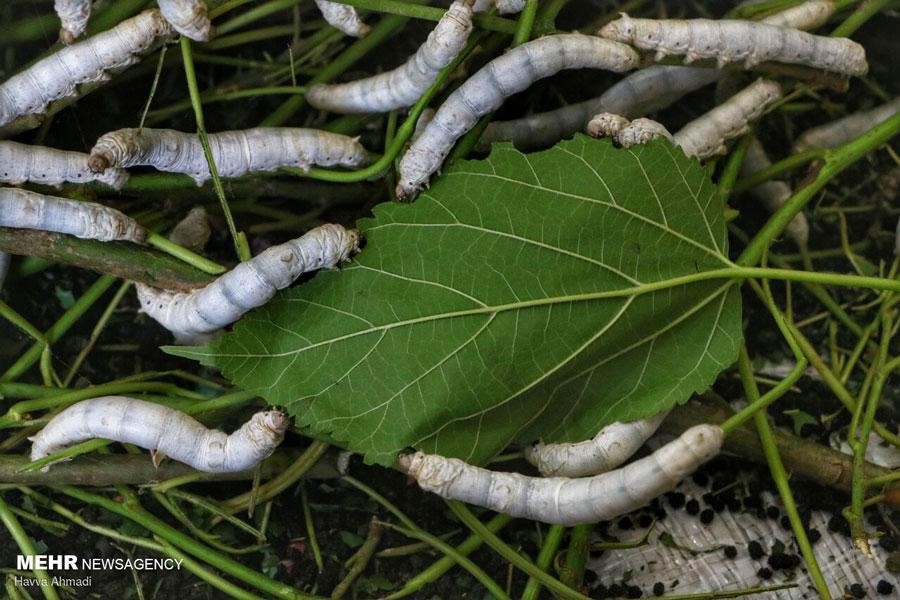
The mulberry tree is the only food source for the silkworm, and this worm is only able to produce cocoons by consuming the leaves of this tree. As you know, silk threads are produced from the cocoon and the resulting fabric has many benefits because of its softness and delicacy. This makes the cultivation of mulberry trees essential to sericulture.
In addition to leaves, the mulberry tree has fruits that contain sugar. These fruits are served both dry and fresh. It is worth mentioning that the cultivation of this tree through the germination of its seeds is not ideal and usually the seedling does not possess the characteristics of the original plant. Unfortunately, most of the mulberry trees in Iran are cultivated through seed germination.
In general, there are two types of mulberries, white and black. Black mulberry trees are not suitable for raising silkworms, but their seeds are used to graft seedlings of modified species. As a result of this process, modified trees are cultivated that can grow leaves several times a year for sericulture.
In general, the methods of mulberry seedling cultivation can be divided into two practices:
Sexual Reproduction
In this method, the mulberry seedlings are cultivated by germinating seeds, which do not possess the characteristics of the original plant. Therefore, it is better to use the seedlings grown in this way for graftage.
Asexual Reproduction
This type of reproduction can be classified into different methods:
- Graftage (such as root grafting, normal or stem-to-root grafting, and inverted grafting)
- Plant cuttings (such as scion cuttings and fresh or stem cuttings)
- Side-Veneer Grafting
Stages of Sericulture
Cultivating silkworms is a multi-stage process, described below:
Hatching Stage
The emergence of the worm from the egg is known as the “hatching stage”, which takes thirteen days if the conditions are suitable. It’s important that after observing the first hatching, silkworm eggs should be placed in a completely dark room with a temperature of 25°C and 80% humidity for 48 hours. These eggs are initially light blue in color but turn dark just as the silkworm hatches.
Larva Stage
Five stages of “feeding” and four stages of “molting” is observed in the silkworm growth process. Each of the feeding stages is known as a stage and the molting stages are known as the sleeping phase. Therefore, each silkworm has five feeding stages and four sleep phases. During the first to third stages, it is known as the larva which lasts eleven days.
Mature Stage
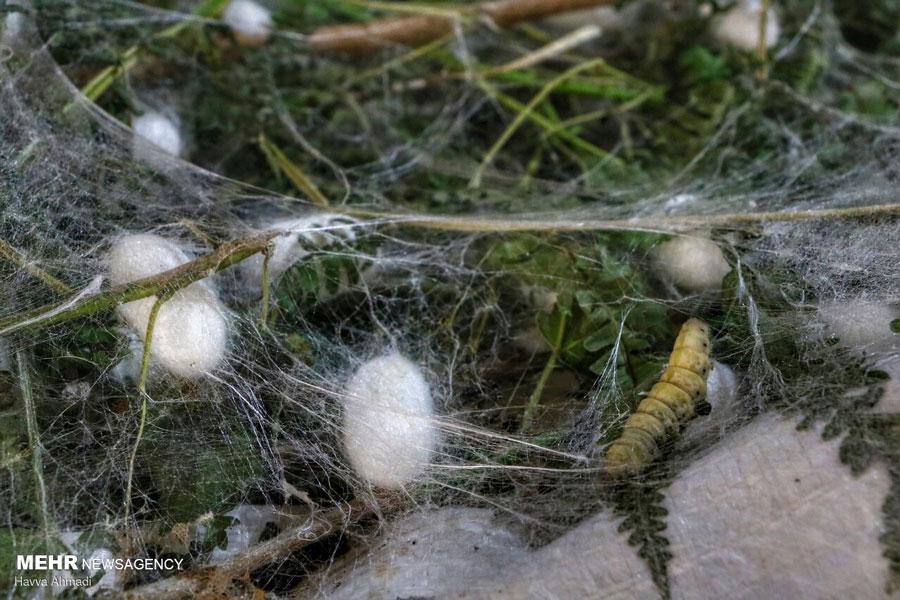
A silkworm reaches maturity after 4 or 5 feeding stages, which lasts about sixteen days. At the end of the fifth stage, the worms’ appetite decreases; They become smaller as a result, and finally, they turn yellow and transparent. At this time, the cocooning basket should be placed near the worms so that they can spin the cocoon.
Metamorphosis and Cocooning
Silk moths usually emerge from their cocoons in early summer. The female lays about 400 small eggs immediately after mating. After two weeks, a larva hatches from the egg, approximately three millimeters long. The larva must be fed on the leaves of the white mulberry tree.
The hatched larva goes through four stages of molting to fully mature. Then, after a month, each silkworm spins a cocoon around itself from silk glands.
By secreting a thin silk thread and using its saliva as an adhesive, it forms the cocoon with a smooth surface. The process takes three days and nights to do this, and based on the characteristics and methods of sericulture, each cocoon may weigh between 1.5 and 2.5 grams.
Although the silkworm cocoon is not used as the primary material in the traditional production of silk for weaving, it is used in the production of raw silk. Two to three days after the formation of the cocoon, the worm turns into a pupa. After two weeks, it emerges from the cocoon as a butterfly. The pupa has multiple uses such as fish food, and manufacturing pharmaceutical and cosmetic products.
Silkworm Dietary Habits
The leaves of the mulberry tree are the only food source that the silkworm selects, but the diet of the young silkworm is slightly different from the adult silkworm. In particular, young silkworms should feed on fresh, tender leaves that grow in the early spring.
The texture of the leaves becomes aged and rough in a matter of days. By this time, the worms also reach maturity and can feed on the aged leaves. However, the leaves must not be contaminated with any pesticides.
How to Store Fresh Mulberry Leaves
If you plan to save the fresh leaves of the mulberry tree, proceed as follows:
- First, sink the leaves in a disinfectant solution for 3 minutes.
- Then rinse them thoroughly with water.
- After shaking the leaves to dry them, put them in plastic bags and store them in a cold space.
Sericulture; A Method for Production of Quality Silk Threads
Silkworm breeding is one of the side activities of Iranian villagers and part of Iran’s intangible cultural heritage. This is how they continue the traditional production of silk for weaving. Silk threads produced in this way are usually used in the weaving of traditional Chelleh silk rugs, which are considered one of the most expensive and valuable types of rugs.
Destination Iran recommends learning more about this art industry and the traditional production of high-quality silk threads for weaving. It is one of the handmade textile products of Iran and a branch of Iranian traditional handicrafts inscribed in UNESCO’s List.
Frequently Asked Questions About Sericulture and Traditional Production of Silk for Weaving
If you cannot find the answer to your questions in the following, share your questions with us through the comments section of this post. We will answer them as soon as possible.
Where can silkworms be cultivated?
Silkworms can be cultivated both at home and in a mulberry orchard. Obviously, cultivating at home will yield a limited amount of silk in comparison.
What are the ideal conditions for a sericulture facility?
If you are cultivating silkworms at home, the cultivation area should be cool and humid. Silkworms should be protected from direct sunlight and their dwelling environment should be cleaned regularly. Wet and withered leaves harm the silkworms and can cause death.
To grow silkworms in an orchard, the cultivation site should be clear of any canals, aqueducts, and water sources. Also, it should not be exposed to wind to keep out any aerosol pollutants. In addition, sericulture orchards should be far away from cement and plaster factories and smelting plants.
What facilities and equipment are needed to grow silkworms at home?
• Cultivation trays in dimensions of 180 x 90 cm
• Cultivation tray’s paper cover
• Paraffin paper
• Tray cleaner nets
• Chicken feathers
• Thermometer and psychrometer
• Finely sifted lime powder
• Formalin, Pafsol and Kabinozan powdered pesticides
• Hatching basket and rack
• Humidifier
How much income and profit can be expected from sericulture?
Sericulture investments usually deliver 50% profit. This profit is obtained after selling the cocoons and deducting production expenses.
What are the advantages and disadvantages of making a sericulture investment?
Sericulture businesses can attract a lot of customers and make a considerable income as a result; in addition to textile and carpet weaving, silk cocoons are used in pharmaceutical and cosmetic products.
Of course, this industry also poses unique challenges: it requires a lot of capital and equipment to launch; The risk of silkworm diseases or pest infestations, and damage to the production chain.
Which pests threaten silkworms?
The most aggressive silkworm pests are house ants and wasps and Exorista bombycis, commonly known as the Uzi fly. It is noteworthy that conventional pesticides should not be used to eradicate these pests; because they also poison the silkworms.






